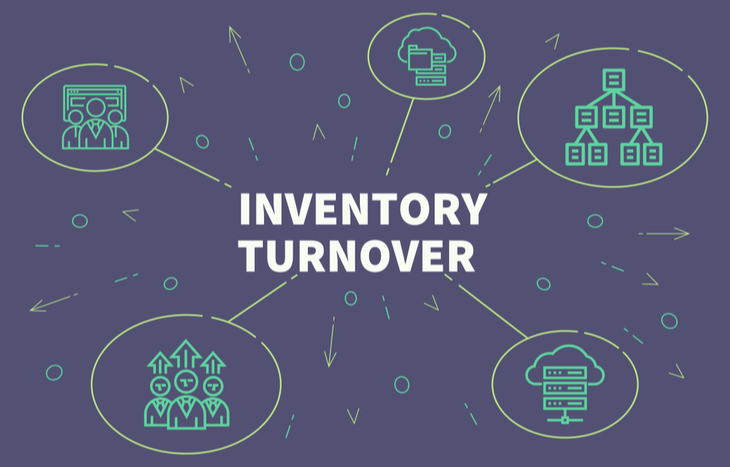What is Inventory Turnover Ratio?
For companies that sell a product, inventory is a major consideration. The more inventory you have, the more money that’s tied up in a static product. Until you sell the product, that money isn’t accessible. It’s in the best interest of every company to keep inventory quickly moving out the door, to bring revenues in. The rate at which a company accomplishes this is its inventory turnover ratio.
Inventory turnover ratio is an efficiency metric. How quickly can the company turn products into revenue? Specifically, it measures the rate at which a company uses up a supply of goods over a specific time frame. The higher the ratio, the more efficient the company is at selling.
Inventory turnover ratio is an important metric for any company that sells products. Not only does it shed insight into sales efficiency, it can also assist in pricing, stocking and purchasing.

What is Inventory?
Investors seeking to compare the efficiency and potential of competing product-based businesses tend to focus on sales. After all, a company’s ability to sell a product is one of the prime determinants of its profitability. But it’s also important to define inventory: the product(s) the company intends to sell.
In this case, inventory is the catalog of goods used to produce profit. It’s typically measured in units, but appears on the company’s balance sheet as a dollar figure based on COGS. When sold, inventory moves from the balance sheet to the income statement as a form of revenue. These two figures are what constitute inventory turnover ratio.
Inventory Turnover Ratio Formula
To understand how efficiently a company turns over its inventory, it’s important to look at the factors that represent turnover. The formula for inventory turnover ratio specifically benchmarks the value of sold inventory vs. the remaining inventory:
Inventory Turnover Ratio = Market Value of Sales / Ending Inventory
This formula takes figures from the income statement and the balance sheet. For example, a company might show sales revenues of $500,000 on its income statement and inventory value of $50,000 from the balance sheet. Investors divide the former by the latter to get an inventory turnover of 10.
For seasonal or cyclical businesses, there’s an alternative method for calculating inventory turnover:
Inventory Turnover Ratio = Cost of Goods Sold (COGS) / Average Inventory
This latter equation uses average inventory as the denominator, which smooths out fluctuations caused by cyclical peaks and troughs. Taking the average inventory for a period gives a more accurate representation of the company’s inventory over time. To calculate average inventory, simply Add the beginning inventory to the ending inventory and divide by the number of months in the accounting period (12 for a year).
What Does Inventory Turnover Ratio Tell Us?
Once a company finds its inventory turnover ratio, it can apply it to forward-looking metrics and use it as an evaluation metric.
For example, if a company has a turnover ratio of 10, it can use this to calculate how quickly it sells or replaces inventory in a given year. The company would divide 365 days by 10 to figure out that it takes roughly 36.5 days to completely sell through inventory.
Looking ahead, the company can then apply this information to its purchasing and stocking strategy. For example, it might choose to stock a rolling 45-day inventory instead of a 60-day inventory, thus keeping its cash flow more liquid. Or, it might choose to negotiate NET 60 terms to give itself a buffer between accounts payable and accounts receivable.
This ratio is also a good comparison metric for evaluating competing businesses. If ABC Company’s ratio is 24 and XYZ Company’s ratio is 18, it means the former sells through inventory 25% quicker than the latter.
For retail stores, location-specific turnover ratio helps companies identify their best- and worst-performing sales from an inventory standpoint. A company might find that stores in certain areas have higher inventory throughput than others, which can shed light on best practices for everything from sales, to inventorying, to marketing.
Important Inventory Considerations
There are a few universally accepted truths associated with inventory turnover ratio. Companies need to keep the following in mind as they evaluate efficiency and performance:
- Turnover ratio and sales are intrinsically tied together. Without sales, inventory can’t become revenue. As a result, high turnover tends to signal strong sales; low turnover correlates with weak sales.
- Companies can adjust inventory levels to create a better turnover ratio. A high inventory turnover ratio can mean inventory is selling out too quickly, while a lower ratio might indicate excessive stock.
- Ideal ratios depend on the industry. Grocery stores will have a much higher inventory turnover rate than car dealerships, for example. Market demand for certain items will influence turnover rates and ratios.
Inventory turnover ratio isn’t a standalone metric. It needs context, including what, exactly, the inventory is, the selling price, its depreciable qualities, etc. It’s a metric companies need to stay on top of as they seek to balance cash flows.
What’s the Best Inventory Turnover Ratio?
There is no “ideal” turnover ratio for inventory; although a lower ratio tends to be better in most cases. Companies that can churn through inventory at a rapid pace without compromising sales or stymying cash flows will find themselves with strong revenues and growth opportunities. Those that struggle to move inventory need to adopt strategies to keep it moving, to lower the turnover ratio. The best inventory turnover ratio is the one a business can sustain.
And while this financial knowledge can be very technical and difficult to understand, it’s important for investors to recognize and analyze. To better understand and interpret the financial information of a business, sign up for the Investment U e-letter below. This daily newsletter is filled with expert stock analysis and financial literacy tips.
[adzerk-get-ad zone="245143" size="4"]




